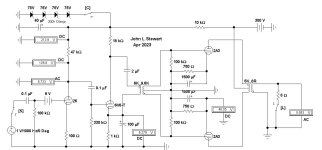The regulators are by Rod Coleman, not Rob. It's possible to use his regs on a 2a3. Just contact him at Lyrima and ask. He'll tell you whether to connect two 2a3 together or use separate regs. You may have a stock of 2a3 tubes. If not consider the 6C4C instead - Russian 6B4G made by Svetlana and very good sound. Still available from ex-Soviet countries but not as cheap as it used to be. Easier to use Rod's regs on that. But ask him anyway. Normally each tube has its own supply and reg, so always separate supplies for the 10Y. I use the 10Y in filament bias which is cleaner, but you don't have to. Be prepared for big heatsinks and cathode resistors above the top plate if you do filament bias, and Rod's regs for the 2a3 need heatsinks too.
My mains transformer has 4 of 2.5V AC windings, with centre taps I think, so designed for 4 x 2a3. It's quite big!
My mains transformer has 4 of 2.5V AC windings, with centre taps I think, so designed for 4 x 2a3. It's quite big!
Toroidy -in Poland- makes 2k5 transformer with such parameters:
https://sklep.toroidy.pl/en_US/p/TTG-EL84PSE-Tube-output-UL-transformer-2,5kOhm-EL84-6V6-PSE/588
TME sells it worldwide.
IMHO 10Y/801a a bit overkill to drive 2A3 PSE, but it's working.
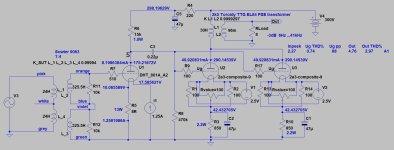
The B+ is low for R loaded 10Y/801a (low anode current), so it's distortion in the higher side.
https://sklep.toroidy.pl/en_US/p/TTG-EL84PSE-Tube-output-UL-transformer-2,5kOhm-EL84-6V6-PSE/588
TME sells it worldwide.
IMHO 10Y/801a a bit overkill to drive 2A3 PSE, but it's working.

The B+ is low for R loaded 10Y/801a (low anode current), so it's distortion in the higher side.
Please forgive me for my very little knowledge of tube amplifier design. I have a question about the Andyjevans schematic. Is it possible to "add" another 2a3 tube? I mean PSE amplifier with 10y tube as driver.View attachment 1165207
Of course Rod, not Rob. My mistake.
euro21, thank you for this scheme.
I just realized this is not a loose thread, it's Jdruin's thread. Sorry for the intrusion. I'll ask the last question and leave.
Euro21, so what should be the optimal B+ for a driver?
In the new amplifier I intend to build a separate power supply for the driver and the output tube. And one more question, where did you make this diagram that you have now presented here? Is it some kind of simulation software???
euro21, thank you for this scheme.
I just realized this is not a loose thread, it's Jdruin's thread. Sorry for the intrusion. I'll ask the last question and leave.
Euro21, so what should be the optimal B+ for a driver?
In the new amplifier I intend to build a separate power supply for the driver and the output tube. And one more question, where did you make this diagram that you have now presented here? Is it some kind of simulation software???
An interesting thread, as I'm currently collecting parts for an 6S4S (6B4G) SET, close enough to 2A3 I guess. Has anyone tried CV1135 (~6J5 with top caps) - LL1660/10mA - 2A3?
I have a pair of LL1660 and some CV1135 on the shelves and this combination might be the first thing to try when I get the prototype up an running.
Probably with the 1660 wired as 4,5:4 to get a small stepdown, as I believe it may sound better than 4:4,5.
In one of my DIY amps, I have Lundahl 2762 as interstate transformer(1:1) between 6j5 and 45. The amp sounds very nice to my ears.
My biggest problem is that the Ua and current is low, so optimal operating point (see 10Y curves) is relatively far (mainly due to the resistive load).Euro21, so what should be the optimal B+ for a driver?
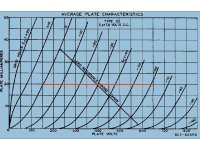
If you want it as driver (150-200Vpp), the Ua must be about 300...400V.
These tubes requires large impedance load, so if it's resistive, it must be -at least- 10..15k.
If you choose the simplest load (resistor) and want to set enough large anode current (in 10Y/801 family is about 15..25mA), the plate load resistor dissipation will growing, and required B+ go to the sky:
Rload voltage: 15k*0.020A = 300V (300V * 0.02A= 6W)
Required Ua: 400V
Summarized B+: 700V !!!!
As you can see, better option to use choke loading (disadvantage large induction: 150..200H), or active load, like CCS/gyrator.
The red line represents 20mA CCS, so the 200Vpp swing (from 0V curve to about -24V curve) feasible with this operating point:
-12V, about 275V, 20mA.
The required B+: 275V + 100V (swing pp/2) + 30V spare for CCS ... about 405V, so 410..430V is appropriate.
As you can see, it's easier to implement than 700V.
Yes - I ran CV1135 into 6C4C for several months before replacing it with a DHT and the 1140-LN-C front end. Very good indirectly heated tube - probably the best I've used. DHTs were better, though, even the 2P29L which is very easy to use in filament bias. I use a resistor load on the driver stage with FT-2 teflon caps.
I don't know if a separate PSE 2a3 thread is needed. There's a lot of collected information on this one.
As for the 10Y in filament bias. It's what I use and I like the sound even at 8.5mA with 15K anode resistor and 196V on the anode and 330V B+, 10.7V bias. I don't use active loads because I don't like the sound, and I prefer coupling with a FT-2 teflon cap rather than use a LL1660, which I have and have tried. I've tried all these alternatives and I chose the best sound for my taste, which is classical music, opera and jazz. Acoustic instruments and voices must be pure, clear, smooth and detailed with nothing artificial in the sound. I didn't get that with active loads or the LL1660. I do have some amorphous plate chokes which I haven't used for a while and they would enable a more obvious operating point, but I'm not in a rush to put them back because I like the sound as it is. The operating point is an endless juggling act in filament bias, especially with a resistor load, but I like the sound of it with no cathode bypass cap.
How this would work into PSE 2a3s I don't know, haven't tried that. It's all in the sound for me - I have a modular system and I build up many, many variations and simply choose the one that sounds the closest to real acoustic instruments and voices. I'm a conservatoire trained pro musician (or was when I was more active) and I'm very familiar with the sound of acoustic instruments as a reference. I don't have the skill or software to do simulations like Bela, so I just build stuff and listen. I'm forever reading his comments and asking questions - he's very generous with his time and skill.
I don't know if a separate PSE 2a3 thread is needed. There's a lot of collected information on this one.
As for the 10Y in filament bias. It's what I use and I like the sound even at 8.5mA with 15K anode resistor and 196V on the anode and 330V B+, 10.7V bias. I don't use active loads because I don't like the sound, and I prefer coupling with a FT-2 teflon cap rather than use a LL1660, which I have and have tried. I've tried all these alternatives and I chose the best sound for my taste, which is classical music, opera and jazz. Acoustic instruments and voices must be pure, clear, smooth and detailed with nothing artificial in the sound. I didn't get that with active loads or the LL1660. I do have some amorphous plate chokes which I haven't used for a while and they would enable a more obvious operating point, but I'm not in a rush to put them back because I like the sound as it is. The operating point is an endless juggling act in filament bias, especially with a resistor load, but I like the sound of it with no cathode bypass cap.
How this would work into PSE 2a3s I don't know, haven't tried that. It's all in the sound for me - I have a modular system and I build up many, many variations and simply choose the one that sounds the closest to real acoustic instruments and voices. I'm a conservatoire trained pro musician (or was when I was more active) and I'm very familiar with the sound of acoustic instruments as a reference. I don't have the skill or software to do simulations like Bela, so I just build stuff and listen. I'm forever reading his comments and asking questions - he's very generous with his time and skill.
Last edited:
My calculation was that the low frequency cutoff would be 4Hz, plenty for just about any listening situation.Your using a 0,082uf cap with a 470k resistor? That is just one break point in the ssytem.
You are losing a whopping ~17% of the bass at 20hz. 8.5% at 40hz, 4.2% at 80hz, and 2% at 160hz.
I was wondering if you are planning on using a separate sub woofer?
cheers
pos
159,155 / 470,000 / 0.082 = 4.12
I typically find that smaller value coupling caps have a faster and more dynamic performance than larger ones of comparable design. I use vintage PIO almost exclusively (as in this case).
The breadboarded 2A3 amp is driving a pair of Lowther PM6A in self-built trapezoidal Onken cabinets, no filter. They produce plenty of bass to my ears.
Nice to see that the CV1135 has a solid reputation here. I bought 8 many years ago, mostly because I thought they would look great next to my RCA 808s in a project that still hasn't been built.
A couple of months ago I bought some 6S4S to build a nice SET but after comparing some amps I already have, I found that my speakers seem to prefer PP amps with a little more power and damping factor than the average small SET can produce, so I ordered some new iron from Lundahl (LL1682 OPTs and LL1660S IT) to build a simple PP class A amp instead with CV1135 and 6S4S.
While waiting for the transformers to arrive I've been messing around a bit with pushing a pair of 6S4S into class A2 operation, with varying results depending on the driver topology.
A couple of months ago I bought some 6S4S to build a nice SET but after comparing some amps I already have, I found that my speakers seem to prefer PP amps with a little more power and damping factor than the average small SET can produce, so I ordered some new iron from Lundahl (LL1682 OPTs and LL1660S IT) to build a simple PP class A amp instead with CV1135 and 6S4S.
While waiting for the transformers to arrive I've been messing around a bit with pushing a pair of 6S4S into class A2 operation, with varying results depending on the driver topology.
I don't think this is a good work point. The static current is too low and the distortion is great!View attachment 1085516
There is an interesting tube for those who would like to experiment with different types of drivers. 6AG9 is a 12-pin compactron that has high current pentode section and medium mu triode section. The schematic above is for the 2A3 driver using the pentode section of 6AG9. As shown, voltage gain is about 55 and bias current is about 8 mA. Only the primary of the 1:1 interstage transformer, and the secondary of input transformer are shown. Of course, the circuit can be modified for RC coupling, cathode bias, and no-transformer input. Screen decoupling capacitor of 0.1 uF is sufficient.
The triode section of 6AG9 is equivalent to paralleled-section 6A6/6N7. Very linear.
Dirt cheap tube.
Andy, or anyone else: what do you think of the regular type 10 tube for driving 2A3? The 10 is specifically designed for audio, has a plate voltage and current range closer to what is needed for driving 2A3, and is also more affordable.
The 10Y is spec'd for much higher voltage and plate current (e.g. 350V/45mA), and appears designed for class C telephony.
The 10Y is spec'd for much higher voltage and plate current (e.g. 350V/45mA), and appears designed for class C telephony.
10Y is "uprated" version of 10, with higher plate dissipation (about 12W - versus 8W).
RCA or Cunningham "type 10" sustain lower current, than VT-25/10Y types (max. 425V/18mA/-39V versus 425V/26mA/-39V).
I have some Sylvania 10 and more VT-25 tubes.
Each of them interchangeable, if you use it with "lower" current within 8W dissipation limit.
I prefer 10, but it's a matter of taste. 🙂
If you read my #362 post, it's clear, that 10/801 "gain" insufficient to drive any power tube without -about- 1:4 step up.
RCA or Cunningham "type 10" sustain lower current, than VT-25/10Y types (max. 425V/18mA/-39V versus 425V/26mA/-39V).
I have some Sylvania 10 and more VT-25 tubes.
Each of them interchangeable, if you use it with "lower" current within 8W dissipation limit.
I prefer 10, but it's a matter of taste. 🙂
If you read my #362 post, it's clear, that 10/801 "gain" insufficient to drive any power tube without -about- 1:4 step up.
Something for Andy J's notebook who had commented how he had built many SE amps but was somewhat unfamiliar with PP.
This one has a DHT frontend that many audiophiles favor. In this vers the bias is simply a 9V battery.
There is a 300V Zener Clamp in the HV cct to prevent PS overvoltage at startup from damaging the 26.
There are many possibilities for the IT & OPT on the market.
The 2A3's are independently biased to minimize difference in their plate currents.
The 6V6 driver circuit is common & used by many audiophiles for a long time.
CG McProud, one of the founders of Audio Magazine used a similar driver in his circuit published in the March 1948 Issue of the magazine.
He added a limited degree of NFB in the driver part of the cct. But did not include the output section.
With a One Volt input this vers makes about 4 watts of audio before losses in the OPT. 1.8V gets about 10 watts of audio.
Something to think about. 👍
This one has a DHT frontend that many audiophiles favor. In this vers the bias is simply a 9V battery.
There is a 300V Zener Clamp in the HV cct to prevent PS overvoltage at startup from damaging the 26.
There are many possibilities for the IT & OPT on the market.
The 2A3's are independently biased to minimize difference in their plate currents.
The 6V6 driver circuit is common & used by many audiophiles for a long time.
CG McProud, one of the founders of Audio Magazine used a similar driver in his circuit published in the March 1948 Issue of the magazine.
He added a limited degree of NFB in the driver part of the cct. But did not include the output section.
With a One Volt input this vers makes about 4 watts of audio before losses in the OPT. 1.8V gets about 10 watts of audio.
Something to think about. 👍
Attachments
I haven't done detailed comparisons with the 10Y but my first impressions are that I like the 10Y. Very close, though.Andy, or anyone else: what do you think of the regular type 10 tube for driving 2A3?
The difference is in the base. The 10Y has a low RF loss Micanol base that allows use as an oscillator or RF power amp to 10 MHz.10Y is "uprated" version of 10
Thats all. Its performance at 10 MHz won't help much at audio, The specs given on the 10Y data sheet are for operation in Class C, not audio.
Attachments
Sometimes 2A3s are built with AC-heat, since you can get the humm to a lower level, compared to filaments with higher voltages. A hum-poti is needed (it is adjusted to give the best cancellation of AC waveform above and below the operating point).In the schematic I see that it is only used for the 10y tube, would it be a good idea to use it also for the 2a3 tube?
When the music signal is applied, the cancellation is less effective; for large-signals, it breaks down. The Triode curves are not symmetrical, looking above and below the operating point.
For this reason, Intermodulation appears in the output: for example: 1kHz ±50Hz, ±100Hz ... and higher harmonics. You can measure it easily using a battery-powered PC and ARTA FFT software.
Of course the spectrum with IMD spurs is not a natural sound, so AC-heat has this big drawback.
If you want to build a 2A3 PSE, the best solution is offered by member 45. He uses the high quality Svetlana 6C4C with LL1627 (no need for custom design OT). You can drive it with the 10. This is good design work, and VERY good value for money!
see for example: 45's 6C4C PSE solution
Depends on how you measure it, and under what conditions. Inductance is NOT a fixed parameter like resistance or capacitance. Frequency, and especially signal level, dramatically affect it. Inductance measured by an LCR meter is therefore meaningless.I've just checked it.
It has 30H @100Hz.
I measured inductance by determining 60 Hz AC voltage drop, with reference inductor connected in series. The voltage across AT-10 was approximately 2 VAC.
RCA Type 10 and -for example- Sylvania 10Y curves are quite differs.The difference is in the base.
See current at 400V, -30V, or 0V curves.
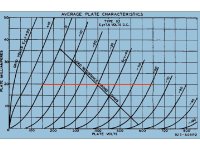
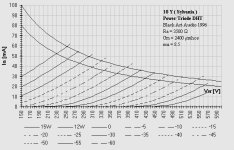
10Y curves shows even 15W dissipation limit (12W is more reliable and safer), my 10 tubes "saturation" never reaches 7.5W.
BTW all of my Sylvania (or Hytron) 10/10Y tubes has similar base.
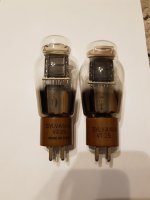
Last edited:
Thanks Andy, euro21, and jhstewart9. It just seems like the 10 is spec'd more reasonably for driving a 2A3 and might potentially run better at that op point than a 10Y in the same role. Anyway, lots of work to get through before I can fiddle with the breadboard again...
- Home
- Amplifiers
- Tubes / Valves
- Developing a 2A3 SET
